Finger Lakes
group of lakes in New York, USA
Wine and water define the Finger Lakes, a region of New York state south of Lake Ontario. Eleven elegantly elongated bodies of water arrayed across 80 mi (130 km) of rolling countryside have produced one of the top wine regions in the country, the East Coast answer to California's Napa Valley.
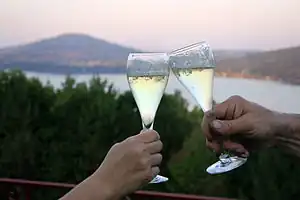
While the wineries that dot the slopes above the Finger Lakes—over a hundred of them—are a major draw, visitors also enjoy the region's many waterways, from the Finger Lakes themselves and Lake Ontario, to the mighty Genesee River and the historic Erie Canal. In the fall, leaf-peepers turn out in force, and wintertime sees skiers heading to the area's slopes.
After a day enjoying the sights and tastes of the Finger Lakes, head to Rochester, the state's third-largest city, for urban amenities and nightlife, or enjoy the college-town atmosphere of Ithaca overlooking Cayuga's waters. Wherever you go, you'll find a friendly, "come look at this next" attitude from the region's residents, each touting a different favorite spot to take a visitor.
Whether you follow the locals, one of the many rural highways, or just your own instincts, the Finger Lakes has culinary—and cultural—flavors to suit any taste.
Regions

| Rochester and Suburbs Although far from the lakes themselves, Rochester and its suburbs provide urban and suburban amenities in a region otherwise dominated by small towns and villages. |
| Finger Lakes Apple Country There may not be any actual Finger Lakes in this area, but the communities along the Erie Canal and Lake Ontario have much in common with the lakeside villages to the south. |
| Western Finger Lakes The western six lakes are smaller and less well known than the eastern five, and you won't find nearly as many wineries, but the Western Finger Lakes have their own attractions. |
| Eastern Finger Lakes The eastern five lakes are the most friendly to grapes, and multiple days can be spent just touring the wineries on circuits around the lakes. |
Cities
- 🌍 Rochester — big-city culture and small-city charm combine in the region's largest city and primary entry point
- 🌍 Auburn — a major crossroads in the eastern Finger Lakes, with urban amenities and historic attractions
- 🌍 Canandaigua — a thriving 19th-century downtown, a large performing arts center, a waterpark, and boating on Canandaigua Lake
- 🌍 Fairport — the village every canalside town wants to be
- 🌍 Ithaca — Cornell University and Ithaca College make for a classic college town atmosphere, set amidst gorges and waterfalls
- 🌍 Naples — where you can get grape-flavored everything
- 🌍 Palmyra — most famous as the birthplace of the Latter-Day Saints movement, also known as the Mormon church
- 🌍 Seneca Falls — a center of the women's rights movement in the 19th-century
- 🌍 Skaneateles — the quintessential lakeside village
Other destinations
- 🌍 Letchworth State Park — The Grand Canyon of the East, with three beautiful waterfalls
Understand
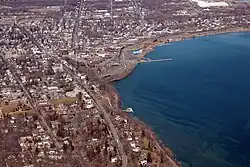
Iroquois legend recounts that the major Finger Lakes are the impressions left by the Great God Manitou's hand when he transplanted a portion of the Happy Hunting Grounds to Earth.
In truth, the Finger Lakes formed after the last Ice Age (see Ice Age traces). Previous glacial retreats had carved out deep valleys across the middle of the state, and rivers flowed southward through them into the Susquehanna watershed, which empties into Chesapeake Bay. But the last Ice Age left a terminal moraine near the southern ends of the valleys, cutting them off from the Susquehanna system. Another moraine farther north acted as a dam and restricted northerly outflow as well, so the valleys filled with water and became the Finger Lakes.
As with most of Upstate New York, the Finger Lakes region is rooted in American Indian heritage. The Sullivan-Clinton Campaign, a major 1779 American military expedition against the Iroquois, took place throughout the region, as detailed on many historical markers in the area.
The Lakes themselves vary from tiny Canadice—a little over 3 miles (5 km) long and less than half a mile (1 km) wide— all the way to the massive Cayuga Lake—40 miles (64 km) from north to south and wider than Canadice is long. From west to east:
- Conesus Lake — tranquil and often forgotten, but notable for its annual Ring of Fire event
- Hemlock Lake — outstanding fishing on a lake surrounded by nearly pristine wilderness
- Canadice Lake — like Hemlock, it is a water source for the city of Rochester, so development is restricted
- Honeoye Lake — also has a Ring of Fire event, and also has outstanding fishing
- Canandaigua Lake — from Canandaigua in the north to Naples in the south
- Keuka Lake — the unique Y-shaped lake features spectacular views, and Penn Yan and Hammondsport on its shores
- Seneca Lake — the deepest Finger Lake is home to Geneva and Watkins Glen
- Cayuga Lake — the longest Finger Lake can be viewed from Cornell University in Ithaca
- Owasco Lake — a relatively shallow lake south of Auburn
- Skaneateles Lake — the most pristine of the Finger Lakes, with crystal-clear water and the charming village of Skaneateles
- Otisco Lake — the lake closest to Syracuse is small and only 60 ft (18 m) deep
Read
The book Summer In a Glass, by Evan Dawson, serves as a definitive guide to Finger Lakes wine, but with a focus on the personalities of the people involved in the industry. It's more of a portrait than a directory or textbook, but few other publications have captured the region's persona in the same way.
Visitor information
Several agencies provide travel information for the Finger Lakes region; the most official is the Finger Lakes Regional Tourism Council, which comprises tourism officials from each of 14 counties (including some from Central New York and the Southern Tier).
Talk
English is universal in this region, with the dialect resembling that of the Midwest more than New York City or New England. Small pockets of German-speakers, mostly the older generation, can still be found. Place names are heavily influenced by Iroquois languages; some are veritable tongue-twisters. Give pronunciation your best shot and you'll get a friendly correction, if needed.
Get in
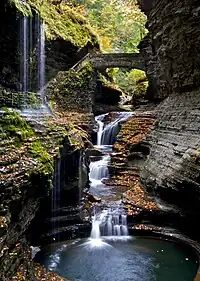
Fly, take a bus, or take a train into Syracuse or Rochester and explore. The Finger Lakes region is only a few hours from New York City by car or bus, or only an hour by plane.
By car
Four major Interstate highways serve the Finger Lakes region. Interstate 90, the New York State Thruway, is a popular toll road that travels between Albany and Buffalo, passing just north of the Finger Lakes and just south of Rochester. Interstate 390 runs south from Rochester and passes just west of Conesus Lake on its way to I-86 and the Southern Tier. I-86 is the Southern Tier Expressway; it connects the Erie, Pennsylvania area to the New York City area, passing through cities like Corning and Binghamton, which are just south of the Finger Lakes region. I-81 is just to the east of the Finger Lakes; it connects Syracuse with Watertown and the Thousand Islands to the north, and with Binghamton and Scranton, Pennsylvania to the south.
By plane
The region has only one full international airport, in Rochester, but Syracuse is close by and easily accessible. Flights to both cities are primarily from hubs such as Chicago, Atlanta, Washington, D.C., Philadelphia, and New York City; actual international flights are now rare. Ithaca's smaller airport also now boasts international customs facilities, though they're only used for charter flights. The Elmira-Corning area (just south of the region) has a small regional airport.
- 🌍 Frederick Douglass Greater Rochester International Airport (ROC), 1200 Brooks Ave (Rochester), ☏ +1 585 464-6000. (updated Feb 2023)
- 🌍 Syracuse Hancock International Airport (SYR), Colonel Eileen Collins Blvd (Syracuse), ☏ +1 315 454-4330. (updated Feb 2023)
- 🌍 Ithaca Tompkins International Airport (ITH), 72 Brown Rd (Ithaca), ☏ +1 607 257-0456. (updated Feb 2023)
- 🌍 Elmira–Corning Regional Airport (ELM), 276 Sing-Sing Rd (Horseheads), ☏ +1 607 795-0402. (updated Feb 2023)
By train
Both Rochester and Syracuse have Amtrak stations, but they're the only stops near this region; Amtrak has no routes in the Southern Tier. Both cities are served by the Lake Shore Limited (Chicago–Boston/NYC), Maple Leaf (Toronto–NYC), and Empire Service (Niagara Falls–NYC) routes. The Empire Service stops in both cities four times daily (two in each direction); the other two pass through twice each day (once in each direction).
Neither station is located in a particularly convenient area, but you'll be able to find connections to regional and long-distance buses, or you can call a taxi or a car rental agency to pick you up.
By boat
The truly adventurous can enter the region from the east or west on the Erie Canal (early May through mid-November). More about navigating the Canal below.
Get around
Most travel in this area will be by car. Unless you are traveling on an organized trip and transportation is already arranged, you will generally want to drive. That said, a few adventurous types might find flying or boating to be feasible.
By car

As noted above, four major highways skirt around the Finger Lakes and allow for quick travel from one side of the region to the other.
Once you get off the expressways, you'll find yourself on well-maintained and well-signed state routes, several of which run north-south between the Finger Lakes to connect the Thruway with the Southern Tier Expressway. Most communities of note in the region are at a crossroads of two or more state routes, so you can usually get where you're going with a minimum of confusion.
By plane
Rochester's is the only major airport in the region, and flying from there to Syracuse or Ithaca just isn't worth it compared to driving. But there are a number of small airstrips around that can accommodate private planes, allowing you the chance to see the Finger Lakes from the air—a rare treat.
By boat
The Erie Canal is a relaxing, scenic way to visit a number of communities in the region. Although it only runs through the northern part of the region, it does connect (through other canals) to Seneca and Cayuga Lakes, allowing easy travel all the way to Ithaca and Watkins Glen.
The canal villages usually have tie-ups near their downtown areas, though availability (and fees) vary. Plan ahead and take note of where locks and bridges are located; they're operated from 7AM–10PM during the peak canal season (mid-May–early September) and 7AM–5PM early and late in the season.
See
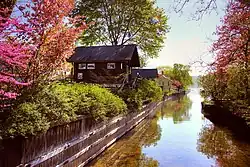
Stop in and see the National Women's Hall of Fame in Seneca Falls.
Cornell University is in Ithaca.
In the summer, the Finger Lakes are home to many great music and arts festivals, including the Finger Lakes GrassRoots Festival of Music and Dance.
Also, check out the Rochester Folk Art Guild, a local community of craftspeople who have been creating fine art for over 35 years.
Skaneateles Village is a must. It's a "cute-as-a-button" StoryBook Village perched on the edge of the lake. The Creamery local historical society can tell you all about the "teasel" and the Lightning Class Sailboat. Watch for their Wooden Boat Show, Chamber Music Festival and Charles Dickens Christmas.
Numerous waterfalls and gorges dot the area. Some are visible directly from main roads, but impressive ones can also be viewed at Watkins Glen State Park, Taughannock Falls State Park, Robert H. Treman State Park and other locales, particularly between Cayuga and Seneca Lakes.
Do
Nestled among the glacial valleys of the Finger Lakes, only a few miles from Canandaigua lake, is a thriving regional hand crafts community: the Rochester Folk Art Guild. The guild has been producing fine art for over 35 years. It hosts a small crafts gallery; as well as the ceramics, woodworking, sewing and weaving workshops located there. 1445 Upper Hill Rd, Middlesex (New York), +1 585-554-5317.
Eat
Settled primarily by German and English immigrants, food in the Finger Lakes is focused on hearty meats and grains – standard American fare, really. But the culinary scene is also influenced by the extensive farmland in this region, so you'll find local products such as apples, sweet corn (maize), and maple syrup to be quite common (at farm markets if not on restaurant menus).
Apples, in particular, are a regional specialty, especially in Wayne County, which grows almost half of the state's apples and is third in the nation on a per-county basis. Lots of local farms offer "U-Pick" apple sales in the fall; even those that don't still see lots of visitors during harvest season, looking for the freshest apples, cider, and other farm goods.
As for restaurants, the variety and quality of meals continue to increase, particularly on the higher side of the price scale. Rochester and Geneva are the hot spots for fine dining, but there are gems throughout the region. If your tastes are less upscale, local eateries like diners, family restaurants, and bars-and-grills can still be found among the chain restaurants, though you may have to head to downtowns rather than commercial strips to find them. On the low end, traditional roadside and waterside burger joints (some of them seasonal) dot the region, along with the national fast-food chains.
Keep an eye out for restaurants on the water (be it a bay, a lake, a river, or the Erie Canal); sometimes they have boat docks right outside for hungry boaters to tie up.
Drink
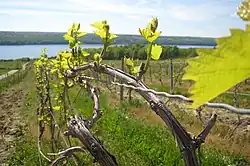
|
Grape Geography
The heat-trapping properties of the Finger Lakes and their valleys make for relatively stable temperatures and an extended growing season. Most of the area's wineries are perched on the valley slopes above the lakes, where fertile soil and favorable air movement produce some of the best grapes in the United States. |
There are almost one hundred wineries dotting the hills surrounding the Finger Lakes. Their reputation grows each year, as travel writers and wine connoisseurs alike discover the area in ever-expanding numbers. Finger Lakes wineries use a wide variety of grapes, but the area's Rieslings turn out especially well; they can compete with the best of Germany's products.
Also not to be missed are the region's many ice wines. Made from grapes harvested while frozen, the local ice wines benefit from upstate New York's harsh winter weather.
If you're just starting out exploring the Finger Lakes wine area, an excellent first stop is 🌍 New York Kitchen in Canandaigua. Formerly the New York Wine and Culinary Center, New York Kitchen has an array of wine tastings and instructional programs, and also features other gastronomic delights from throughout Western New York.
The Cayuga Wine Trail has a flavorful and educational tour every spring featuring herbs and food at each wine tasting stop. The Seneca Wine Trail is the most active of the wine trails, boasting the biggest lake, most reputable wineries, and most activities.
Individual wineries vary in the number of amenities available. Most have tastings, of course, but many go beyond that; you'll find tours of the fields and bottling areas, gift shops, and sometimes cafes or restaurants.
One of the most award-winning of the individual wineries is 🌍 Dr. Konstantin Frank Vinifera Wine Cellars in Hammondsport. Other popular wineries are 🌍 Bully Hill Winery in Hammondsport and 🌍 Fox Run Vineyards in Penn Yan.
Of course, if you can't get to the wineries themselves, countless restaurants throughout Western New York have local wines on their wine lists.
Sleep
Rochester and its suburbs have a full range of hotels from downtown high-rises to cheap motor inns to extended-stay suites. Ithaca, Auburn, Geneva, and Canandaigua also have a good variety of accommodations, including some historic properties. Outside the cities, you'll find a mix of sprawling luxury resort hotels, cozy beds & breakfasts, and basic roadside motels.
Stay safe
If traveling in this area during the winter months, be aware that heavy snowfalls are possible. Lake effect snow has been known to drop 4 ft (1.2 m) of snow in a weekend, or more. It is not unusual during heavy storms for it to come down at a rate of 1 in (25 mm) per hour.
Watch out for slow-moving Amish/Mennonite horsedrawn vehicles on rural roads.
When visiting state parks with trails to waterfalls or gorges, obey all posted signs. Do not swim or wade in creeks or plunge pools. Be aware that some trails require lengthy stair climbs that small children, elderly people or pets may not be able to handle (signs at parks will not always warn you of this).
Go next